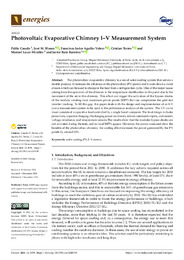Por favor, use este identificador para citar o enlazar este ítem:
https://hdl.handle.net/11000/35366Registro completo de metadatos
| Campo DC | Valor | Lengua/Idioma |
|---|---|---|
| dc.contributor.author | Casado, Pablo | - |
| dc.contributor.author | Blanes, Jose M. | - |
| dc.contributor.author | Aguilar-Valero, Francisco Javier | - |
| dc.contributor.author | Torres Vergara, Cristian | - |
| dc.contributor.author | Lucas Miralles, Manuel | - |
| dc.contributor.author | Ruiz Ramírez, Javier | - |
| dc.contributor.other | Departamentos de la UMH::Ingeniería Mecánica y Energía | es_ES |
| dc.date.accessioned | 2025-01-28T09:14:38Z | - |
| dc.date.available | 2025-01-28T09:14:38Z | - |
| dc.date.created | 2021 | - |
| dc.identifier.citation | Energies | es_ES |
| dc.identifier.issn | 1996-1073 | - |
| dc.identifier.uri | https://hdl.handle.net/11000/35366 | - |
| dc.description.abstract | The photovoltaic evaporative chimney is a novel solar-cooling system that serves a double purpose: it increases the efficiency of the photovoltaic (PV) panels and it cools down a water stream which can be used to dissipate the heat from a refrigeration cycle. One of the major issues arising from the operation of the chimney is the temperature stratification in the panel due to the movement of the air in the chimney. This effect can trigger the activation of the bypass diodes of the module, creating local maximum power points (MPP) that can compromise the grid-tied inverter tracking. To fill this gap, this paper deals with the design and implementation of an I–V curve measurement system to be used in the performance analysis of the system. The I–V curve tracer consists of a capacitive load controlled by a single board computer. The final design includes protections, capacitor charging/discharging power electronics, remote commands inputs, and current, voltage, irradiance, and temperature sensors.The results show that the modules bypass diodes are not activated during the tests, and no local MPPs appear. Moreover, the curves measured show the benefits of the photovoltaic chimney: the cooling effect increases the power generated by the PV panels by around 10%. | es_ES |
| dc.format | application/pdf | es_ES |
| dc.format.extent | 14 | es_ES |
| dc.language.iso | eng | es_ES |
| dc.publisher | MDPI | es_ES |
| dc.relation.ispartofseries | 14 | es_ES |
| dc.relation.ispartofseries | 24 | es_ES |
| dc.rights | info:eu-repo/semantics/openAccess | es_ES |
| dc.rights.uri | http://creativecommons.org/licenses/by-nc-nd/4.0/ | * |
| dc.subject | solar cooling | es_ES |
| dc.subject | PV | es_ES |
| dc.subject | I–V curves | es_ES |
| dc.subject.other | CDU::6 - Ciencias aplicadas::62 - Ingeniería. Tecnología::621 - Ingeniería mecánica en general. Tecnología nuclear. Electrotecnia. Maquinaria | es_ES |
| dc.title | Photovoltaic Evaporative Chimney I–V Measurement System | es_ES |
| dc.type | info:eu-repo/semantics/article | es_ES |
| dc.relation.publisherversion | https://doi.org/10.3390/en14248198 | es_ES |

Ver/Abrir:
2021 energies-14-08198.pdf
2,65 MB
Adobe PDF
Compartir:
 La licencia se describe como: Atribución-NonComercial-NoDerivada 4.0 Internacional.
La licencia se describe como: Atribución-NonComercial-NoDerivada 4.0 Internacional.
.png)